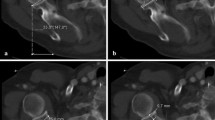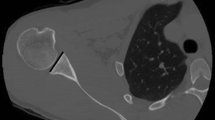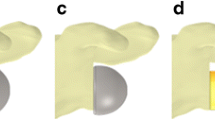Abstract
Background
Despite the variability in glenoid sizes geographically, most of the currently available commercial glenoid component designs are based on the glenoid parameters of the Caucasian population which may not be suitable for the Indian population due to a mismatch between the prosthesis and native anatomy. The aim of the present study is to systematically review the literature to determine the average glenoid anthropometric parameters in the Indian population.
Methods
A comprehensive literature search was conducted using preferred reporting items for systematic reviews and meta-analyses guidelines in the PubMed, EMBASE, Google Scholar, and Cochrane Library databases from the date of inception to May 2021. Any observational study conducted on the Indian population measuring the glenoid diameters, glenoid index, version, inclination, or any other glenoid measurements were included in the review.
Results
A total of 38 studies were included in this review. The glenoid parameters were assessed on intact cadaveric scapulae in 33 studies, on 3DCT in three studies, and 2DCT in one study. The pooled average of glenoid dimensions are as the following- the superoinferior diameter or height was 34.65 mm, anteroposterior1 diameter or maximum width was 23.72 mm, anteroposterior2 diameter or maximum width of the upper part of the glenoid was 17.05 mm, the glenoid index was 67.88, and the glenoid version was 1.75-degree retroversion. Males were having a mean height of 3.65 mm and maximum width of 2.74 mm larger than the females. A subgroup analysis revealed no significant difference between different parts of India in glenoid parameters.
Conclusion
The glenoid dimensions in the Indian population are smaller compared to the average European and American populations. The average glenoid maximum width of the Indian population is 1.3 mm smaller than the minimum glenoid baseplate size available in reverse shoulder arthroplasty. Glenoid components specific to the Indian market need to be designed to reduce glenoid failure attributable to the above findings.
Level of evidence
III.






Similar content being viewed by others
Data availability
All data supporting the findings of this study are available within the paper and its Supplementary Information. Additional data can be made available on request to corresponding author.
References
Matsen, F. A., Clinton, J., Lynch, J., et al. (2008). Glenoid component failure in total shoulder arthroplasty. The Journal of Bone and Joint Surgery-American Volume, 90, 885–896.
Dillon, M. T., Chan, P. H., Prentice, H. A., et al. (2020). The association between glenoid component design and revision risk in anatomic total shoulder arthroplasty. Journal of Shoulder and Elbow Surgery, 29, 2089–2096.
Piponov, H. I., Savin, D., Shah, N., et al. (2016). Glenoid version and size: Does gender, ethnicity, or body size play a role? International Orthopaedics, 40, 2347–2353.
Matsumura, N., Oki, S., Ogawa, K., et al. (2016). Three-dimensional anthropometric analysis of the glenohumeral joint in a normal Japanese population. Journal of Shoulder and Elbow Surgery, 25, 493–501.
Ankushrao, D. S., & Dombe, D. D. (2017). Morphological and morphometrical study of scapulae in western Indian population. Indian Journal of Clinical Anatomy and Physiology, 4, 298–303.
Sheth, U., & Saltzman, M. (2019). Reverse total shoulder arthroplasty: Implant design considerations. Current Reviews in Musculoskeletal Medicine, 12, 554–561.
Mathews, S., Burkhard, M., Serrano, N., et al. (2017). Glenoid morphology in light of anatomical and reverse total shoulder arthroplasty: A dissection and 3D-CT-based study in male and female body donors. BMC Musculoskeletal Disorders. https://doi.org/10.1186/s12891-016-1373-4
Meshram, P., Pawaskar, A., & Kekatpure, A. (2020). 3D CT scan-based study of glenoid morphology in Indian population: Clinical relevance in design of reverse total shoulder arthroplasty. Journal of Clinical Orthopaedics and Trauma, 11, S604–S609.
Deepali, R. K., Ashutosh, A., Ajay, C., et al. (2016). Osseous anatomy of glenoid: Cadaveric study. International Journal of Anatomy and Research, 4, 2473–2479.
Sinha, P., Bhutia, K. L., Kumar, T. B., & Sarda, R. K. (2016). Morphometric study of glenoid cavity of dry human scapula. International Journal of Medical Research Professionals. https://doi.org/10.21276/ijmrp.2016.2.3.020
Rajput, H. B., Vyas, K. K., & Shroff, B. D. (2012). A study of morphological patterns of glenoid cavity of scapula. National Journal of Medical Research, 2, 504–507.
Mamatha, T., Pai, S. R., Murlimanju, B. V., et al. (2011). Morphometry of glenoid cavity. The Online Journal of Health and Allied Sciences, 10, 1–4.
Pal, M., Sarma, H. P., & Guha, I. (2018). Glenoid cavity of scapula in Indian population: A morphometric analysis. Journal of Anatomical Society of India, 67, S71–S72.
Gosavi, S., Jadhav, S., & Garud, R. (2014). Morphometric study of scapular glenoid cavity in Indian population. IOSR Journal of Dental and Medical Sciences, 13, 67–69.
Sahu, D., Jagiasi, J. D., Valavi, A. S., & Ubale, T. (2019). The distance between the pectoralis major tendon insertion and the top of the humeral head is a reliable landmark: An anatomic study. Joints, 7, 37–40.
Raaj, M. S., Felicia, C., Sundarapandian, S., & Ashma, K. A. (2018). Morphologic and morphometric analysis of glenoid cavity of human scapula. International Journal of Research in Medical Sciences, 7, 52.
Sahu, D., Joshi, M., Rathod, V., et al. (2020). Geometric analysis of the humeral head and glenoid in the Indian population and its clinical significance. JSES International, 4(4), 992–1001.
Jagiasi, J. D., Valavi, A. S., Ubale, T. V., & Sahu, D. (2018). Humeral head and glenoid dimensions in the Indian population: A cadaveric study. International Journal of Anatomy and Research, 6, 5760–5764.
Vinay, G. (2016). A morphometric study of scapular glenoid cavity. Journal of Anatomical Society of India, 65, S2.
Bamne, A. (2017). Determination of the native angles of glenoid and humerus head version of adult skeletons At Karad, Maharashtra, India. International Journal of Anatomy and Research, 5, 4707–4710.
Patil, G. V. (2015). Morphometrical study of scapular glenoid cavities. Journal of Anatomical Society of India, 64, S3.
Thute, P. P., Keche, H. A., & Fulmali, D. G. (2020). Morphometric study of glenoid cavity of human scapula in Central India. Journal of Evolution of Medical and Dental Sciences, 9, 2340–2344.
Singh, R. (2020). Surgical anatomy of the glenoid cavity and its use in shoulder arthroplasty among the north indian population. Cureus. https://doi.org/10.7759/cureus.11940
Yadav, Y., Potdar, P., & Dhakar, J. (2020). Morphometric study of glenoid cavity of scapulae in north Indian population with clinical significance. Santosh University Journal of Health Sciences, 5, 78–81. https://doi.org/10.18231/j.sujhs.2019.016
Morelli, K. M., Martin, B. R., Charakla, F. H., et al. (2019). Acromion morphology and prevalence of rotator cuff tear: a systematic review and meta-analysis. Clinical Anatomy, 32, 122–130.
Khalkar, A., & Jadhav, S. (2020). Morphology and morphometry of glenoid cavity and it’s clinical significance. Indian Journal of Applied Research, 6(10), 49–51.
Uma, S., & Balasubramanyam, V. (2016). Morphometry of glenoid using digital photographs and image processing software. International Journal of Anatomy and Research, 4, 2720–2724.
Chhabra, N., Prakash, S., & Mishra, B. K. (2015). An anatomical study of glenoid cavity: its importance in shoulder prosthesis. International Journal of Anatomy and Research, 3, 1419–1424.
Liberati, A., Altman, D. G., Tetzlaff, J., et al. (2009). The PRISMA statement for reporting systematic reviews and meta-analyses of studies that evaluate healthcare interventions: explanation and elaboration. BMJ, 339, b2700.
Bodanki, C., Yadoji, H. K., Maryada, V. R., & Annapareddy Venkata, G. R. (2021). Three Dimensional anthropometric analysis of glenoid anatomy in normal Indian population. Indian Journal of Orthopaedics, 55, 861–868.
Henry, B. M., Tomaszewski, K. A., Ramakrishnan, P. K., et al. (2017). Development of the anatomical quality assessment (AQUA) tool for the quality assessment of anatomical studies included in meta-analyses and systematic reviews. Clinical Anatomy, 30, 6–13.
Study Quality Assessment Tools. (2021). NHLBI, NIH. https://www.nhlbi.nih.gov/health-topics/study-quality-assessment-tools. Accessed 19 Jun 2021
Patel, S., Shah, M., Vora, R., et al. (2013). Morphometric analysis of scapula to determine sexual dimorphism. International Journal of Medicine and Public Health, 3, 207.
Shewale, S. N., Laeeque, M., Sukre, S. B., & Patil, S. C. (2017). Morphometric study of glenoid cavities of scapulae in Marathwada population. International Journal of Anatomy and Research, 5, 3759–3765.
Lingamdenne, P. E., & Marapaka, P. (2016). Measurement and analysis of anthropometric measurements of the human scapula in Telangana region, India. International Journal of Anatomy and Research, 4, 2677–2683.
Mourad, W., Wiater, J. M., Wiater, B. P., & Martusiewicz, A. (2020). Baseplate options for reverse total shoulder arthroplasty. Current Reviews in Musculoskeletal Medicine, 13, 769–775.
Coskun, N., Karaali, K., Cevikol, C., et al. (2006). Anatomical basics and variations of the scapula in Turkish adults. Saudi Medical Journal, 27, 1320–1325.
Churchill, R. S., Brems, J. J., & Kotschi, H. (2001). Glenoid size, inclination, and version: An anatomic study. Journal of Shoulder and Elbow Surgery, 10, 327–332.
Hassanein, G.H.E.-S. (2015). Morphometry of glenoid fossa in adult Egyptian scapulae. International Journal of Anatomy and Research, 3, 1138–1142.
Aigbogun, E. O., Oladipo, G. S., Oyakhire, M. O., & Ibeachu, C. P. (2017). Morphometry of the glenoid cavity and its correlation with selected geometric measurements of the scapula. Bangladesh Journal of Medical Science, 16, 572–579.
Wang, H., Tang, K., Gong, J., et al. (2009). Measurement and analysis of glenoid bony anatomy by use of three-dimensional computed tomography. Chinese Journal of Reparative and Reconstructive Surgery, 23, 822–826.
Mizuno, N., Nonaka, S., Ozaki, R., et al. (2017). Three-dimensional assessment of the normal Japanese glenoid and comparison with the normal French glenoid. Orthopaedics & Traumatology, Surgery & Research, 103, 1271–1275.
Rosales-Rosales, L., Rosales-Varo, A. P., García-Espona, M. A., et al. (2019). Anthropometrical study of the human glenoid in a normal Spanish population. Revista Española de Cirugía Ortopédica y Traumatología, 63, 327–335.
Polguj, M., Jȩdrzejewski, K. S., Podgórski, M., & Topol, M. (2011). Correlation between morphometry of the suprascapular notch and anthropometric measurements of the scapula. Folia Morphol (Warsz), 70, 109–115.
Iannotti, J. P., Gabriel, J. P., Schneck, S. L., et al. (1992). The normal glenohumeral relationships. An anatomical study of one hundred and forty shoulders. Journal of Bone and Joint Surgery. American Volume, 74, 491–500.
Lombardo, D., Kolk, S., Frank, C., & Sabesan, V. (2016). Computational assessment of glenoid morphology in us and Australian patients. Orthopaedic Proceedings, 98-B, 6.
Cabezas, A. F., Krebes, K., Hussey, M. M., et al. (2016). Morphologic variability of the shoulder between the populations of North American and East Asian. CiOS Clinics in Orthopedic Surgery, 8, 280–287.
El-Din, W. A. N., & Ali, M. H. M. (2015). A morphometric study of the patterns and variations of the acromion and glenoid cavity of the scapulae in Egyptian population. Journal of Clinical and Diagnostic Research, 9, AC08-AC11.
Chaijaroonkhanarak, W., Amarttayakong, P., Ratanasuwan, S., et al. (2019). Predetermining glenoid dimensions using the scapular dimensions. European Journal of Orthopaedic Surgery & Traumatology, 29, 559–565.
Jung, H. J., Jeon, I. H., Ahn, T. S., et al. (2012). Penetration depth and size of the nonarthritic glenoid: Implications for glenoid replacement. Clinical Anatomy, 25, 1043–1050.
Varghese, S., & Madhavan Chandramathi Amma, M. (2017). Morphometric study of dry human scapulae. Journal of Evolution of Medical and Dental Sciences, 6, 5365–5371.
Vardhan, H., Chuhan, S. K., Modi, S. (2019). Study of morphology of glenoid cavity of scapula : Done on dry bone specimen in the department of anatomy of MGM medical college Jamshedpur. International Journal of Medical and Health Research, 2, 91–94
Vaishnani, H., Jethva, K., Rathwa, A., & Sharma, P. (2018). Morphometry and Morphology of Glenoid Cavity of Scapula. International Journal of Anatomy and Research, 6, 4798–4802.
Singh, A., Singh, A., Agarwal, P., & Gupta, R. (2019). A morphological and morphometric study of glenoid fossa of scapula and its implication in shoulder arthroplasty. International Journal of Anatomy Radiology and Surgery, 8, 10–13.
Shalom, P. E., & Dakshayani, K. (2018). A morphometric study of glenoid cavity and its implication in shoulder arthroplasty and prosthetic designs. National Journal of Clinical Anatomy, 7, 190–194.
Mahto, A. K., & Omar, S. (2015). Dimensions of glenoid fossa of scapula: implications in the biomechanics of an implant design. International Journal of Scientific Study, 3, 146–148.
Akhtar, M., Kumar, B., Fatima, N., & Kumar, V. (2016). Morphometric analysis of glenoid cavity of dry scapulae and its role in shoulder prosthesis. International Journal of Research in Medical Sciences, 4, 2770–2776.
Chavan, S. R., Bhoir, M., Verma, S., & Professor, A. (2017). A study of anthropometric measurements of the human scapula in Maharashtra, India. International Journal of Anatomy, 1, 23–26.
Dhindsa, G. S., & Singh, Z. (2014). A study of morphology of the glenoid cavity. Journal of Evolution of Medical and Dental Sciences, 3, 7036–7044.
Gupta, S., Magotra, R., & Kour, M. (2015). Morphometric analysis of glenoid fossa of scapula. Journal of Evolution of Medical and Dental Sciences, 4, 7761–7766.
Kalra, S., Thamke, S., Khandelwal, A., & Khorwal, G. (2016). Morphometric analysis and surgical anatomy of coracoid process and glenoid cavity. Journal of Anatomical Society of India, 65, 114–117.
Kavita, P., & Jaskaran, S. (2013). Morphology of coracoid process and glenoid cavity in adult human scapulae. International Journal Of Pharmaceutical And Bio-Medical Science, 2(2), 62–65.
Nyffeler, R. W., Sheikh, R., Atkinson, T. S., et al. (2006). Effects of glenoid component version on humeral head displacement and joint reaction forces: An experimental study. Journal of Shoulder and Elbow Surgery, 15, 625–629.
Reich, D., Thangaraj, K., Patterson, N., et al. (2009). Reconstructing Indian population history. Nature, 461, 489–494.
Thati, B., Bodanki, C., Badam, V. K., et al. (2020). Custom 3D printed jigs in salvage reverse shoulder arthroplasty for failed four-part proximal humerus fracture fixation: A case report. Journal of Orthopaedic Case Reports, 10, 25–28.
Kim, M. S., Rhee, Y. G., Oh, J. H., et al. (2022). Clinical and radiologic outcomes of small glenoid baseplate in reverse total shoulder arthroplasty: A prospective multicenter study. Clinics in Orthopedic Surgery, 14, 119.
Hasler, A., Meyer, D. C., Tondelli, T., et al. (2020). Radiographic performance depends on the radial glenohumeral mismatch in total shoulder arthroplasty. BMC Musculoskeletal Disorders, 21, 1–9.
Chae, S. W., Kim, S. Y., Lee, H., et al. (2014). Effect of baseplate size on primary glenoid stability and impingement-free range of motion in reverse shoulder arthroplasty. BMC Musculoskeletal Disorders, 15, 1–7.
Funding
There is no funding source.
Author information
Authors and Affiliations
Contributions
SP: Writing of manuscript, manuscript preparation, Data abstraction and analysis. MA: Planning of study, writing of manuscript, Data abstraction and analysis. LD: Data abstraction. BSR: Quality analysis. RBK: Data abstraction and analysis, proofing of manuscript.
Corresponding author
Ethics declarations
Conflict of Interest
The authors declare that they have no conflict of interest.
Ethical Approval
This study was exempted from any ethical clearance.
Informed Consent
Informed consent was obtained from all individual participants included in the study.
Additional information
Publisher's Note
Springer Nature remains neutral with regard to jurisdictional claims in published maps and institutional affiliations.
Rights and permissions
Springer Nature or its licensor (e.g. a society or other partner) holds exclusive rights to this article under a publishing agreement with the author(s) or other rightsholder(s); author self-archiving of the accepted manuscript version of this article is solely governed by the terms of such publishing agreement and applicable law.
About this article
Cite this article
Paul, S., Arora, M., Das, L. et al. Average Indian Glenoid Sizes Are Smaller than All Commercially Available Glenoid Components: A Systematic Review. JOIO 57, 1008–1022 (2023). https://doi.org/10.1007/s43465-023-00885-8
Received:
Accepted:
Published:
Issue Date:
DOI: https://doi.org/10.1007/s43465-023-00885-8




